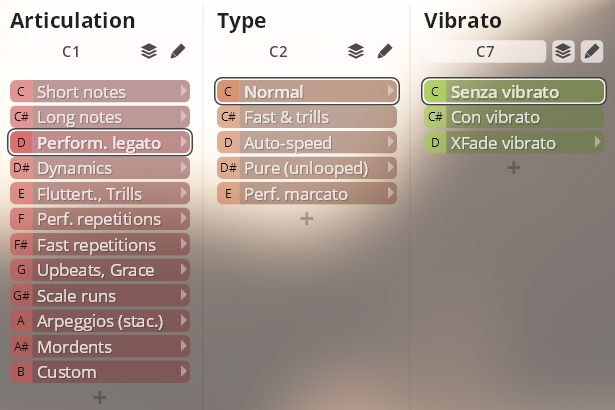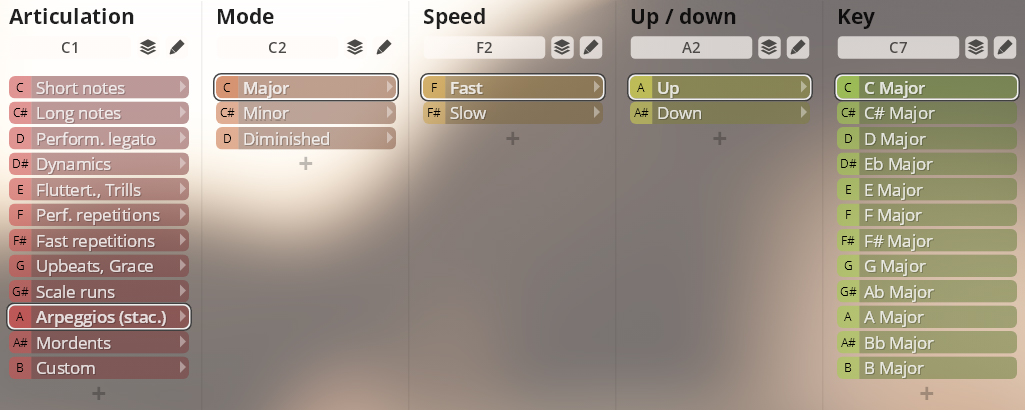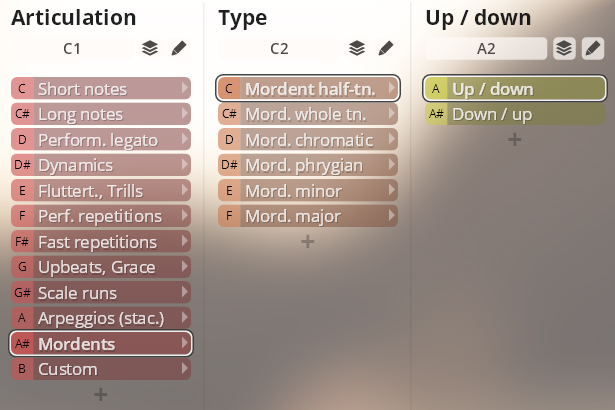Introduction
The Library Studio Brass is based on the Vienna Instruments Library Brass I, with the addition of Trumpet in Bb, Triple horn, and Bass trombone, while Studio Special Brass derives from Brass II, Special Brass, and the remaining VI brass single instruments. The instruments were optimized for the Vienna Synchron Player, and perfectly balanced to interact with other Synchron Series Libraries. The original recordings were done at our “dry” venue, the Silent Stage. We reprocessed, re-edited and remastered the data from these recordings in order to achieve a sound that excels in terms of aesthetics, playability and realism, and that is also optimized for use alongside the Synchron Series instruments.
Our goal was to improve the instruments’ playability and realism even more, which we achieved by enhancing the sample recordings as well as by utilizing the Synchron Player’s unique features. This document will provide you with information about the Library’s structure and how it looks in the environment of our Vienna Synchron Player.
Instruments
The Studio Brass Collection includes the following instruments, which cannot be purchased separately. These provide you with the foundation of an orchestral brass section:
Trumpet in C
Trumpet in Bb
Trumpet ensemble, 3 players
Viennese horn
Triple horn
Horn ensemble, 4 players
Tenor trombone
Trombone ensemble, 3 players
Bass trombone
Tuba
The instruments of Studio Special Brass are available individually so that you can expand your brass sections as you need them:
Piccolo trumpet
Trumpet in C, muted
Trumpet in Bb, muted
Trumpet ensemble, 3 players, muted
Trumpet ensemble, 6 players (Fanfare Trumpets)
Bass trumpet
Cornet
Flugelhorn
Viennese horn
Triple horn
Horn ensemble, 8 players (Epic Horns)
Alto trombone
Tenor trombone, muted
Trombone ensemble, 3 players, muted
Contrabass trombone
Euphonium
Cimbasso
Wagner tuba
Contrabass tuba
Synchron libraries generally offer different Presets according to how velocity is handled, arranged in separate folders.
“VelXF sus - MOD”: velocity crossfading is only activated for long notes, while the dynamics of short notes as well as marcato options are controlled by keystroke velocity, thus facilitating phrasing.
“VelXF - MOD”: all articulations have velocity crossfading activated so that you can control dynamics with MIDI controller CC1, the modwheel.
“Velocity”: note volume is controlled generally by keystroke velocity just like a piano.
Apart from that, velocity crossfading can always be enabled or disabled by clicking its on/off symbol in the Synchron Player's Perform tab.
Presets are subdivided into single and multiple note categories; within these, you can select specific articulations, e.g., regular single notes, or Major glissandos. If you happen to be short of RAM, you can deactivate Articulations you do not need, and activate them again if necessary.
Switching between playing styles and articulations is generally done via dedicated keys on the keyboard which are therefore called “keyswitches”. These range from C1 to F#1 for soprano and alto saxophone, and from C5 to F#5 for the low saxophones. Other keyswitches, such as release, direction, or speed, depend on articulation.
Patches can be used to build your own custom Presets and adapt the Synchron Libraries to your specific requirements. For further information on constructing Presets, please see the Synchron Player manual.
In the instrument Presets you can also find a slot called "Custom" which contains 6 empty slots you can use to start creating your own setups.
This library was recorded at the Silent Stage, our "dry" recording studio, so that you can use them in different reverb environments including our MIR PRO 3D software. For the Synchron Player, we added a specifically designed convolution reverb derived from Vienna MIR Pro to the Synchron Player, featuring the outstanding and unique ambience of the 540 m2 (5,813 sq.ft.) main hall of Synchron Stage Vienna. The perfectly engineered reverberation and placement presets combine customized impulse responses with expertly crafted reverb settings for each group of the ensemble. By adding the ambience of Synchron Stage Vienna’s Stage A to the dry samples in real-time, Studio Orchestral Strings perfectly blend with any other product of our Synchron Series.
For each instrument, there are a number of general Mixer Presets that depict different recording situations: Close, Classic, Distant, short and long Reverb without convolution, and MIR unprocessed for implementation in Vienna MIR Pro 3D.
For designating pitch, the Vienna Symphonic Library uses International Pitch Notation (IPN), which was agreed upon internationally under the auspices of the Acoustical Society of America. In this system the international standard of A=440 Hz is called A4 and middle C is C4. All pitches are written as capital letters, their respective octave being indicated by a number next to it. The lowest C on the piano is C1 (the A below that is A0), etc.
The Synchron Player software allows you to set middle C to C3, C4, or C5 according to your preference. Selecting another setting than C4 will of course also change the play ranges and keyswitches accordingly.
Most of a preset’s slots are accessed by way of keyswitches, starting with the basic articulation, which is the first dimension of the preset array. Articulations consist of one or more types, which again may offer further options, such as attack or vibrato variants.
Some instruments offer regular and sordino (i.e., muted or stopped) articulations. Where these are contained in separate libraries (e.g., the trumpets in C and Bb), you will find a merged preset that combines both. In other instruments like the tuba, they are already integrated.
Regular / sordino: A0/A#0; contrabass tuba A4/A#4.
Articulation keyswitches: high instruments starting at C1, low ones at C5.
Type keyswitches: starting from C2 / C6 depending on instrument range.
Other keyswitches such as vibrato options etc. are mapped to higher keyboard ranges.
Crossfading, e.g., between with and without vibrato, is normally handled with the help of a MIDI controller.
Some instruments will have copies of existing articulations in slots where a certain articulation is missing. This is necessary especially with regular and sordino variants so that everything stays in place in the merged preset. It also facilitates switching between different instruments.
In the following, the Trumpet in C is described as an example of instrument structure. Of course, the articulations of a trombone or tuba will be somewhat different, but adhere to the sampe principle. In the horn ensemble with 8 players, for instance, you will even find major and minor chords …
Staccato; portato short; portato medium with normal, soft, and marcato attack; portato long with normal, soft, and marcato attack as well as senza, poco, and molto vibrato.
Attack (portato medium and long): A2–B2.
Release (portato long): A7–B7.

Long notes regular senza, poco, molto, and with progressive vibrato, as well as several crossfading variants.
Vibrato: C7–G7.

XFade Vibrato
Uses MIDI CC20 to control crossfading between vibrato variants.
XF vibrato: Dim.Ctrl/C (MIDI CC20).

Legato regular (with and without vibrato) and fast with an additional auto-speed patch; pure legato with unlooped samples, and performance marcato with normal and fast attack, also including an auto-speed option.
Vibrato (normal, pure): C7–C7.
Attack (marcato): A2–B2.

XFade Vibrato
Uses MIDI CC20 to control crossfading between vibrato variants.
XF vibrato: Dim.Ctrl/C (MIDI CC20).

Auto-speed
Legato normal and fast, as well as marcato with normal and fast attack. The legato resp. attack type is selected according to playing speed.
Speed: Dim.Ctrl/D (playing speed)

Sforzato, fortepiano, sforzatissimo; crescendo and diminuendo light, medium and strong; piano-forte-piano.
Crescendo and diminuendo light
Light crescendo and diminuendo without vibrato at 1.5/2/3/4/6 seconds.
Duration: G7–B7.

Crescendo and diminuendo medium / strong
Medium crescendo and diminuendo without vibrato 1.5/2/3/4/6 seconds; with vibrato, 2/3/4/6 seconds.
Strong crescendo and diminuendo without vibrato 2/3/4/6 seconds; with vibrato, 3 and 6 seconds.
Both medium and strong crescendo also offer an XFade vibrato slot that contains patches of identical duration.
Vibrato: C7–D7.
Duration: G7–B7, starting keyswitch depending on availability of duration.
XF vibrato: Dim.Ctrl/C (MIDI CC20).

Piano-forte-piano
Piano-forte-piano, with vibrato, 4/6/8 seconds; without vibrato, 4/8 seconds. For consistency reasons, senza vibrato contains a duplicate of the 8 seconds patch.
Vibrato: C7–D7.
Duration: A#7–C7.
XF vibrato: Dim.Ctrl/C (MIDI CC20).
Flutter tonguing, normal and crescendo; half and whole tone trills, fast, slow, and accelerando.
Trill speed: F2–G2.

Performance repetitions
Performance repetitions legato slow and fast, portato, and staccato slow and fast, static and dynamic. Legato crescendos and diminuendos have 5 repetitions, the others 9.
Static/cres/dim: A2–B2.

Auto-speed
A combination of the static repetition patches with legato/portato starting notes. Starting note and repetition type are selected depending playing speed.
Speed: Dim.Ctrl/D (playing speed)

Fast repetitions normal, normal with cut release, crescendo, and diminuendo at 140/150/160/170/190/210 BPM.
Tempo: F#7–B7.

Upbeats, 1/2/3 repetitions, 90–160 and 180 BPM; grace notes, half and whole tone, up and down.
Upbeats
Upbeat tempo: C#7–G#7.

Grace notes
Up/down: A2/A#2.

Octave runs, major and minor, up and down.
Scale: C7–B7.
Up/down: A2/A#2.

Arpeggios over an octave, staccato, major, minor, and diminished, fast and slow, up and down. The arpeggios are mapped to their respective starting notes.

Chord (major and minor only): C7–B7.
Fast/slow: F2/F#2.
Up/down: A2/A#2.

3-note mordents: half tone, whole tone, chromatic, phrygian, minor, and major.

Scale: C2–D#2 / C6–D#6.
